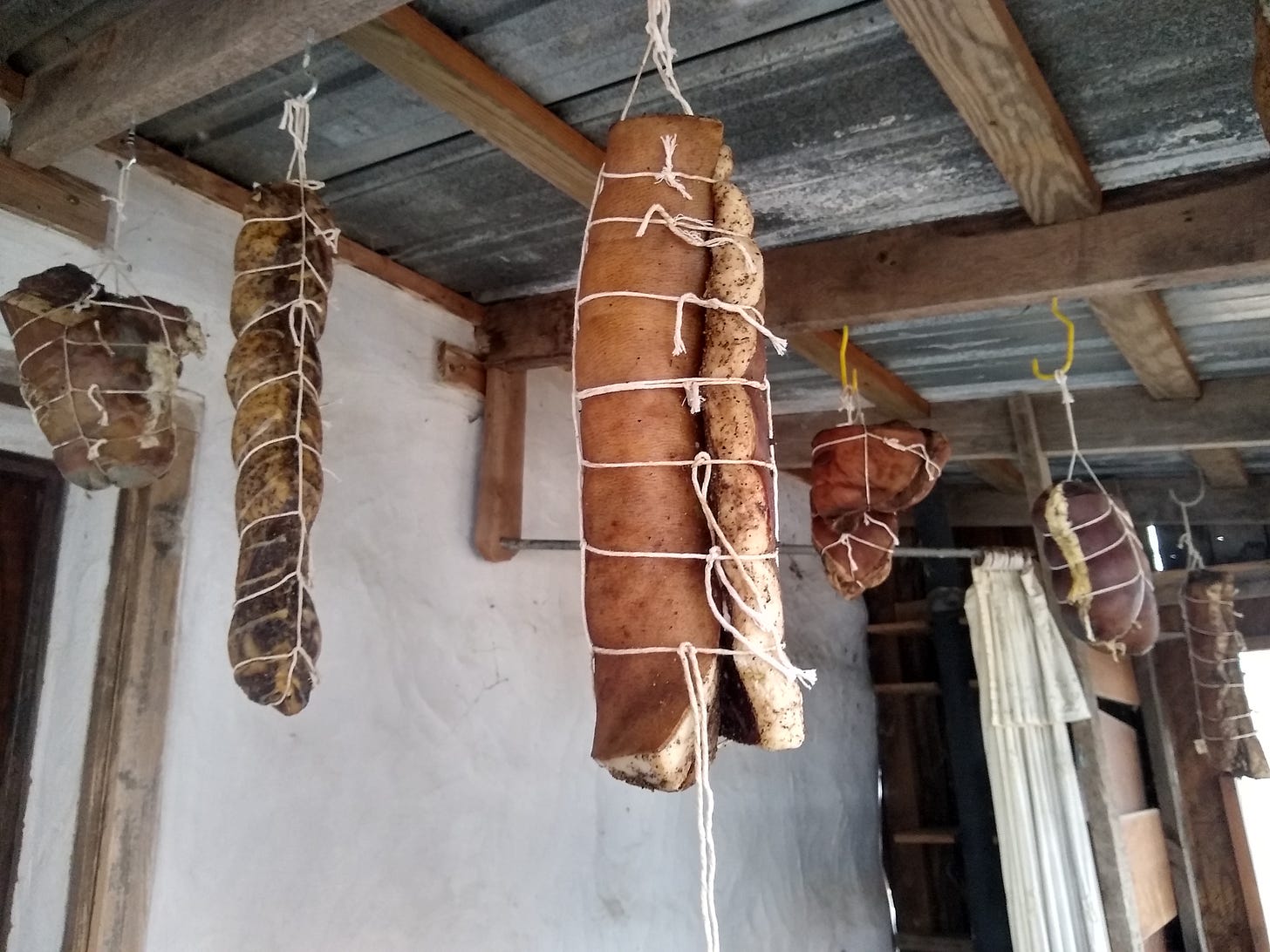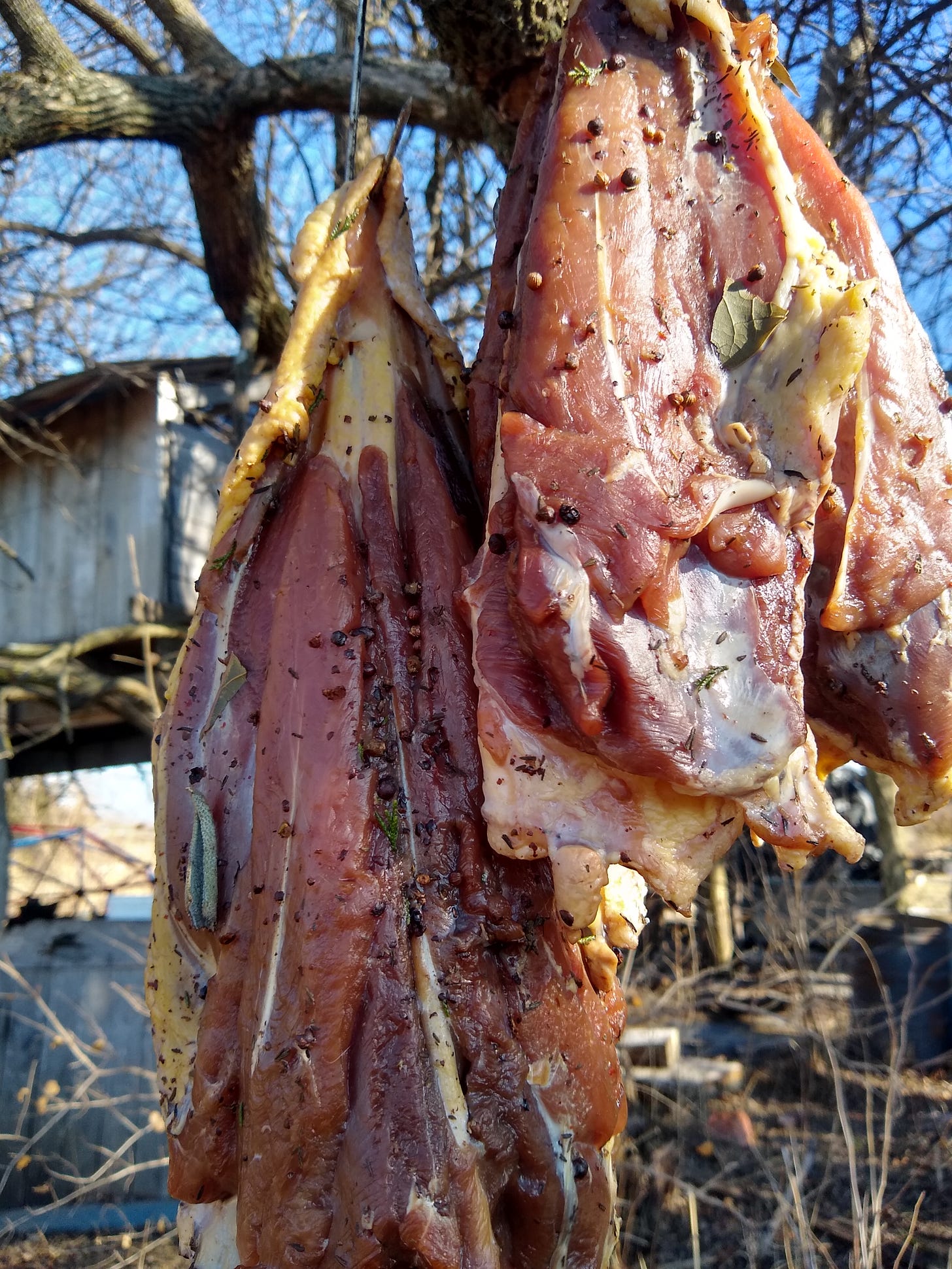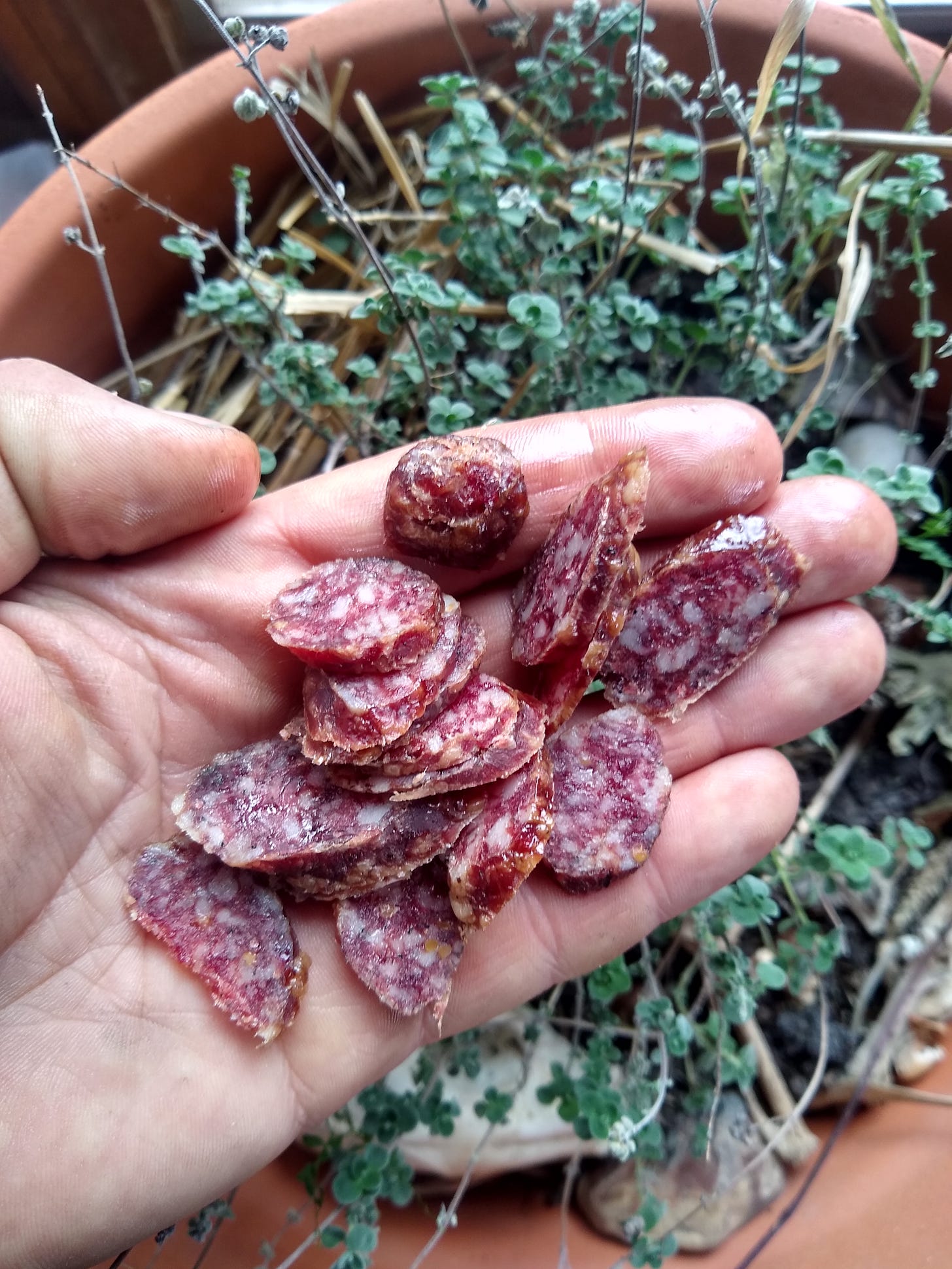Charcuterie for the People
... in which the author reckons with life, death, and the afterlife of swine, snatches salami off the metaphorical charcuterie board of the culinary elite and returns it to humbler hands.
I saw a fly outside today. Nature is telling me something. The time of setting maple spiles is the same time that we begin to take down the various salt-cured hams, bellies and jowls from hogs killed in November. They have been hung there in a breezy, shaded shed to dry and develop, each ham carefully stitched inside swine gut, bellies rubbed with aromatic, pest-repelling spices, rolled and tied into neat pancetta, the salted, slightly sweating loins undergoing enzymatic change at a snail’s pace, packed comfortably into the bowels of a cow. I will take these down, the swelling fruits of slaughter, and they will again become animate flesh for me to use in my own body.
Much of this meat will be used by my family and I for survival. Before our frozen soil breaks through winter slumber and issues forth chickweed, nettle and cress, we will enrich our meager provisions of squash and root with salted, translucent fat and dense, stable protein. A slice of hog jowl, guanciale, quickly heated and laid over a stale bread heel somehow becomes a meal soft and holy. It’s no wonder the rich have taken this from us and given us Lunchables.
Charcuterie oughtn’t be an elite food. It is a simple method to preserve flesh and fat for the winter without the energy excesses of powered refrigeration. It is a long standing practice around the world, employed by nomadic hunters, subsistence agrarians, and straight up peasants. It often uses the odd tidbits unsuitable for the tables of lords and royals, or those which could not be easily transported fresh. Fat, skin, sinew, and offal. Lips and assholes, if you will. When it comes to assholes and charcuterie, there is but one rule to remember: Each animal only has one, but you can typically fit five or six around a charcuterie board, if you charge enough.
As someone actively trying to sell my surplus charcuterie, I want you to know that I’m halfway joking. I’d like to think that at the end of the day, the folks who support my work are doing so because they share the same ethic for a simpler, more ecological agriculture. But my altruism does mellow a bit when I have to pay my lease.
The origin of much of the charcuterie we’ve come to know in modern times, like ham, bacon, and salami, go back to the medieval peasantry. A portion of the rent in those days was paid in meat. The leaner, most tender bits, (higher on the hog) were skimmed off by the powerful, and those who performed the herding and husbandry were left to stuff paunch, bladder, and bowel with blood and perishable organs. In some instances, intestines were literally stuffed with more intestines (the original French andouille). The precious packages would be salted, preserved in rendered fat, dried, smoked, fermented, and/or heavily herbed to repel pests and overpower rancidity, and then put up for year round consumption, all the better to help the turnips go down. In organized, urban medieval society the skills of the butcher and charcutier were eventually regulated through artisanal guilds. This lended itself to the early development of regulated public health practices related to fresh and preserved meats as well as food distribution infrastructure. Today, we have the USDA and FDA to perform this role.
I’m not a huge fan of bureaucracy, but I do think that we have a complex enough food supply chain to necessitate the government spending its time recalling e. Coli beef. The negative result of having a bureaucracy that protects us from the corporate food system that will cut any corners it can is that it makes it pretty much illegal to sell preserved meat, crafted on farm by the careful hands of the swineherd, without $2 million in the bank. The same goes for cheese. It is true that even well-intentioned people can make mistakes, and that those mistakes could end in blindness or death. Rarely, though, because the modern-day charcuterier has access to affordable tools, like litmus paper and reliable curing salts, to all but eliminate the need for worry. A basic sausage making text is indispensable, not to mention affordable. The value of artisan guilds was that a person could take an apprenticeship to learn how to approach meat preservation safely and confidently. That is perhaps a bit more out of reach to the average person. Salami and ham might seem like magic, but with an accurate scale, the proper ingredients, and good hygiene, it is magic that can be harnessed by anyone.
We had an intense, short-term cold snap a few days ago, as often happens in February. We haven’t had the weeks of bone-numbing cold as the result of a polar vortex this year, yet. Nonetheless, it got very frigid at an inopportune time for us. Peach, our sow, was accidentally bred too late last year and she farrowed six piglets on one of the coldest days this winter. Throughout the day we spent time assembling an insulated strawbale fort around her nest, to try and keep her litter warm throughout the night. We have three groups of pigs in wintertime: One group consisting of our boar, Tomato, and a few young barrows for company, the other two comprised of two sows each and their young progeny. We allow these pigs to exist in a natural herd arrangement that mimics the social structure of wild swine rather than the confined and compartmentalized form of hog husbandry widely practiced in industrial agriculture. One of the advantages of our “alternative” system is that the pigs can all cuddle together on cold nights beneath a mattress of insulative straw bedding rather than use climate control to make the energy cost of our meat any greater. It also allows the pigs to engage in their full range of natural behaviors. But on a cold night, a cuddle puddle of pigs can lead to smothering with 2 pound piglets, so we cordoned off a section of barn for just Peach and her babies.
As happens when you’ve done this for awhile, one piglet just wasn’t right. She was restless, twitchy, clearly enduring some type of neurological damage. Being soft, we brought her into our home for 36 hours, syringe feeding her warm milk. We even milked some colostrum out of the sow to ensure this piglet had a healthy start. The next morning we had one loss. I always hope for better than this, but considering the weather, it could have been a lot worse. As a farmer, I do my best to ensure that death is always delivered with intention and care. Losing newborn livestock is never easy, but it does become unsurprising. What is suprising is that our twitchy little “off” piglet is hanging in there.
That morning I was busy. I had work to do related to my charcuterie, and still more work to ensure the survival, safety, and comfort of these new piglets. I fed everyone, hauled water, applied extra bedding, and placed the perfect little piglet, dead, into a bucket. I laid him in the embracing dirt, and put him away, food for the microbes and decomposers. Then I washed my hands and took down a fat firm pancetta, examined it and measured its weight, logging the economic value in my notebook. Up on a new hook, ready to be sliced into dollar-an-ounce pinwheels of creamy fat and lustrous red flesh it waits, unctuous, rich, splendidly shining, with a pleasant, cheesy aroma. And in the center of a pile of compost rests the piglet, undergoing a similar transformation, albeit with a different, more earthy terroir, and unaccounted for, economically. This is what makes assigning a dollar value to this work so hard for me.
Life begins and ends on this farm all the time. Chicks hatch, kids drop, maggots wriggle, microbes multiply. Now and then, a stiffened hen slumps in a nesting box, victim to natural causes. I cannot imagine performing the alchemical work of the charcutier outside of this context, but that is exactly how the vast majority of commercial products are manufactured. With costly conveniences such as refrigeration, air travel, and culinary labs, the amateur sausage maker can order freeze-dried bacterial cultures from around the world to give their home salami the same microbiology as southern Italy, and then place the frankenstein monster theyv’e stitched together into a thermostatically controlled, bluetooth compatible curing chamber that can simulate a mediterranean climate for 60 days. I refer to this as “Dad-Core Charcuterie” and all the internet forums are chock full of it. I support people having hobbies, but a ham or sausage so out of context from the soils upon which the living beast thrived feels soulless and pointless to me. I wonder about these things as I prepare a delivery of buttermilk-fermented duck sausage for a prestigious urban restaurant. I am always grateful to have my work seen and supported, but I am left with curiosity if the life of this pig matters when it is being consumed a three hour drive away from the bones of its forebears.
This work feels too important for me to just quit, and yet the economic incentives are slight at this scale, and the ethics questionable. And so I’d like to do the work of teaching. It felt empowering to learn these skills from the person who mentored me in charcuterie. This far into my journey I am confident in my work as a butcher and charcutier. I would like the opportunity to empower others in the future, to renew the sanctity of the ham, that marriage of flesh, air, minerals, microbes and time. To put sausage back in the context of the farm and the hands of common people.
As for the culinary elite who insist a nice coppa or saucisson sec must be cured at X percentage humidity at Y duration and with only Z bacterial culture, let them eat offal. Cured meat happens to be a delicacy if only because its flavor reflects the dynamic conditions which created it. The merging of stockmanship and diet, handling and climate. It is delicious because it is unique. One year our swine may fatten on acorns, the next year walnuts. I may have an abundance of wild cherry, or honey locust, or apple wood for smoking, depending on circumstances. I may use buttermilk, whey, or sauerkraut to kick off fermentation. It is both art and science to preserve meat, and requires both a resolute understanding of food safety science and an ability to improvise. I don’t believe it can truly be replicated across distance and culture, but with enough money thrown at it, it might taste approximately the same, minus that certain something. But a true ham, or headcheese, or cellar aged rillette, that only exists within the vernacular of place, it only arises from the relationship between steward, land, and the microbial life that will never conform to our modern desire for control. And for those of us who harvest and preserve with what we have killed, the value of this material thing, this treasure of flesh, well, it’s hard to stick a price tag on. How do we quantify this miraculous combination of controlled and uncontrollable conditions, this precious jewel manifested by our toilsome hands?
A dollar an ounce is my going rate.
Humbly yours,
BB






I am looking forward to hear how your desire to teach cones to fruition. Many are beginning to turn their eye to learning these largely lost skills.